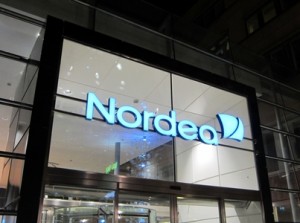Nordea in FIG reopener, SEB joins in seven year sweet spot
Feb 13th, 2014
Sweden’s Nordea was one of three issuers that reopened the FIG bond market after a week-and-a-half without supply on Monday, pricing a Eu1.25bn seven year senior unsecured deal. SEB followed suit on Wednesday with a Eu1bn deal, also in the “sweet spot” seven year maturity.
The deals came after the banks reported fourth quarter results, SEB having done so last Wednesday (5 February) and Nordea on 29 January, and followed a period of market volatility that contributed to keeping new FIG flow issuance at bay since late January.
Goldman Sachs and UBI Banca were in the market alongside Nordea on Monday to provide the first euro benchmark bank bond supply of the month, with the good momentum in the FIG primary markets continuing until today (Thursday), when activity was slower.
 Nordea priced its Eu1.25bn seven year deal at 63bp over mid-swaps on the back of around Eu2.6bn of demand. Leads Barclays, Credit Suisse, Nordea and Société Générale first marketed the transaction with initial price thoughts of the high 60s and then set guidance at the 65bp over area.
Nordea priced its Eu1.25bn seven year deal at 63bp over mid-swaps on the back of around Eu2.6bn of demand. Leads Barclays, Credit Suisse, Nordea and Société Générale first marketed the transaction with initial price thoughts of the high 60s and then set guidance at the 65bp over area.
At 63bp over, Nordea offered a new issue concession of 8bp-10bp, according to a syndicate official at one of the leads.
“There hasn’t been that much senior unsecured supply so there were a lot of questions about what the right new issue premium was, but it went really well,” he said. “The issuer came out of blackout and was looking at the market and conditions were good.
“Non-farm payrolls weren’t brilliant but the market performed well after, and Nordea got a lot of focus in the market.”
Another syndicate banker said that although the hunt for yield continues to favour peripheral credits, “core issuers are getting good deals done” when paying a new issue concession of 8bp-10bp.
UBI Banca was the standout financial institutions trade on Monday, drawing nearly twice the volume of demand as Nordea and Goldman did — the order book for the Italian issuer’s transaction is said to have amounted to around Eu4.2bn, with nearly 300 investors participating.
The lead syndicate official on Nordea’s new issue said that the seven year maturity is a “sweet spot” at the moment, with insurance companies not that interested in longer maturities given recent yield movements and asset managers attracted to the incremental yield available relative to that in five years.
“Seven years was the maturity that made the most sense,” he said.
Around 190 accounts participated in Nordea’s transaction. Germany and Austria took 26%, France 21%, the UK 17%, the Benelux 13%, and the Nordics 8%. Asset managers were allocated 52%, banks 21%, insurance companies and pension funds 19%, SSAs 7%, and others 1%.
Goldman Sachs also opted for seven years for its deal on Monday, a Eu1bn issue that was priced at 108bp over, and the 2021 maturity bracket was chosen by SEB for its new issue, too.
The deal met with some Eu1.6bn of demand and was priced at 65bp over, after initial price thoughts of the high 60s. Barclays, BNP Paribas, Deutsche Bank and SEB were lead managers.
A syndicate banker away from the trade noted the similarities with Nordea’s transaction in terms of the maturity and the spread at which it was marketed, while another said that pricing 2bp back of Nordea was a good outcome.
“It’s a decent print in terms of the pricing,” he said.
Germany and Austria took 32% of SEB’s new senior unsecured bonds, the Nordics 17%, the UK and Ireland 12%, France 11%, the Benelux 8%, Asia 7%, Switzerland 4%, the rest of Europe 5%, and the rest of the world 4%.
Fund managers were allocated 45%, banks 27%, insurance companies and pension funds 16%, SSAs 7%, and others 5%.








